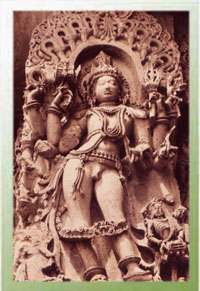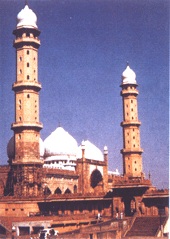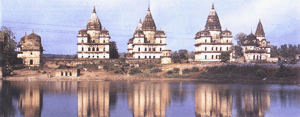|
The
Chandelas, the ambitious builders and great connoisseurs of
atrs, embellished their cities and towns with palaces, pools,
and temples, but the comples of sunshines at Khajuraho
represents the climax, the best and most spectacular specimens
of Hindu temple architecture and sculpture in medieval India.
The capital of the Chandela Kings, Khajuraho is famous for its
magnificent temples dedicated to Lord Shiva, Lord Vishnu and
the Jain Tirthankaras. These temples are built between 950
A.D. and 1050 A.D. The temples of Khajuraho represent some of
the most exquisite specimens in medieval India, only 22
temples out of 85 now survive.
For
many centuries after the Chandela dynasty's decline in the
13th century, the temples were concealed by dense jungles.
Khajuraho was re-discovered by captain T.S. Burt, a British
army engineer in 1838.
General
information
|
Rainfall
|
114
cm. (July-September)
|
|
Best
Season
|
October
to March
|
|
Temperature
|
Summer
: Max. 47 Deg. C. Min. 21 Deg. C.; Winter : Max. 32
Deg. C. Min. 4 Deg. C.
|
|
STD
Code
|
076861
|
How
to get there
Air
Khajuraho
is connected with Delhi and other major cities.
Rail
Jhansi
(175 Km. )
and Satna (117 Km.) are the two convinient railheads to visit
Khajuraho from Bombay, Delhi & Madras. However Harpalpur
(110 Km,) is the nearest railhead to visit Khajuraho. )
and Satna (117 Km.) are the two convinient railheads to visit
Khajuraho from Bombay, Delhi & Madras. However Harpalpur
(110 Km,) is the nearest railhead to visit Khajuraho.
Road
Khajuraho
is connected with major tourist centres by good motorable
roads. Some important distances from Khajuraho are: Agra (395
km), Allahabad (285 km), Bandhavgarh (237 km), Bhopal (372 km)
Chitrakoot (176 km), Delhi (590 km), Jabalpur (296 km) Lucknow
(267 km) and Varanasi (415 km)
In and around
The temples of Khajuraho are divided into three
geographical groups viz, Western, Eastern, and Southern
groups.
Western
Group of Temples
Chausath Yogini
One
of the three granite temples in Khajuraho. Dedicated to Kali,
it is also unique in being quadrangular. Only 35 of the
original 65 cells remain and the image is the earliest
surviving shrine
Kandariya Mahadeo
It
is the largest and most typical Khajuraho temple. Perfectly
symmetrical, it soars 31m high.
Devi
Jagdamba Temple
Another Kali temple, originally dedicated
to Vishnu.
Chitragupta
Temple
North
of Devi Jagdamba temple and facing eastwards to the rising
sun, dedicated to Surya, the Sun God. The idol, an imposing 5
feet in height, is driving a seven-horsed chariot.
Vishwanath
Temple
The
steps leading to the temple on the northern side are flanked
by lions and on the southern side by elephants. There is a
impressive three-headed image of Brahma inside.
Eastern
Group of Temples
Brahma Temple, Vamana Temple and Javari Temple
A double row of celestial nymphs adorn the outer wallsof the
Vamana temple in a variety of sensuous attitudes. Granite was
used in the construction of the Brahma temple.
Parsvanath
Temple
The
largest Jain temple in this group. Sculptures on the northern
outer wall make this timeless, of a woman bending thoughtfully
over a letter, a damsel removing a thorn from her foot.
Ghantai
Temple
Bearing evidence of its original splendour, particularly
arresting is a frieze depicting the dreams of Mahavir's mother
and a multi armed Jain goddess riding on the winged Garuda.
Southern
Group of Temples
Dulhadeo
Temple
It
is dedicated to Lord Shiva and shows women sporting around
trees.
Chaturbhuj
Temple
It
has a massive intricately carved image of Vishnu.
Raneh
falls
19
km, on the Ken river are famous for their rock formations.
The main attractions is a 5 km long, 100 foot deep canyon made
of pure crystalline granite in varying shades of colours
ranging from pink and red to grey.
|







